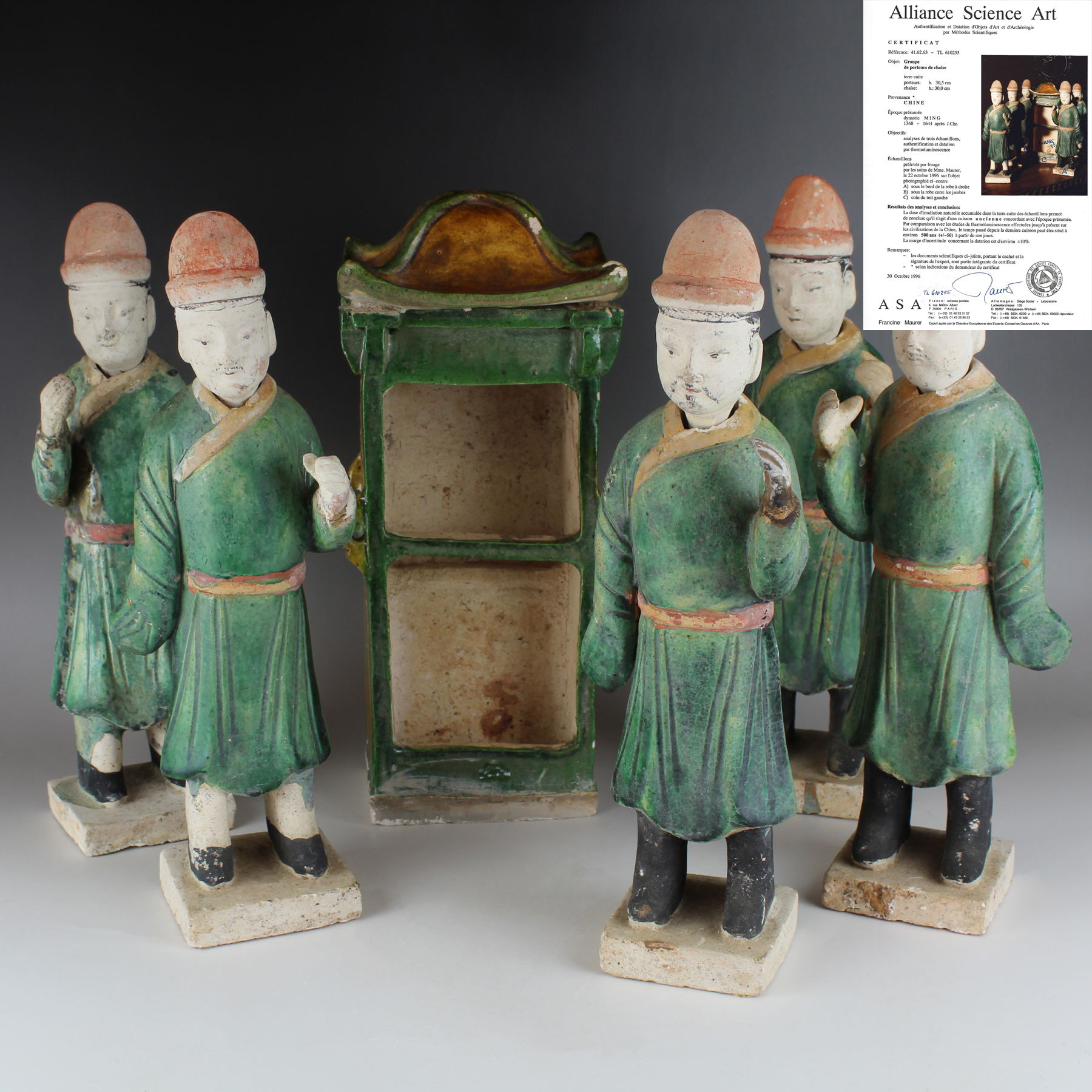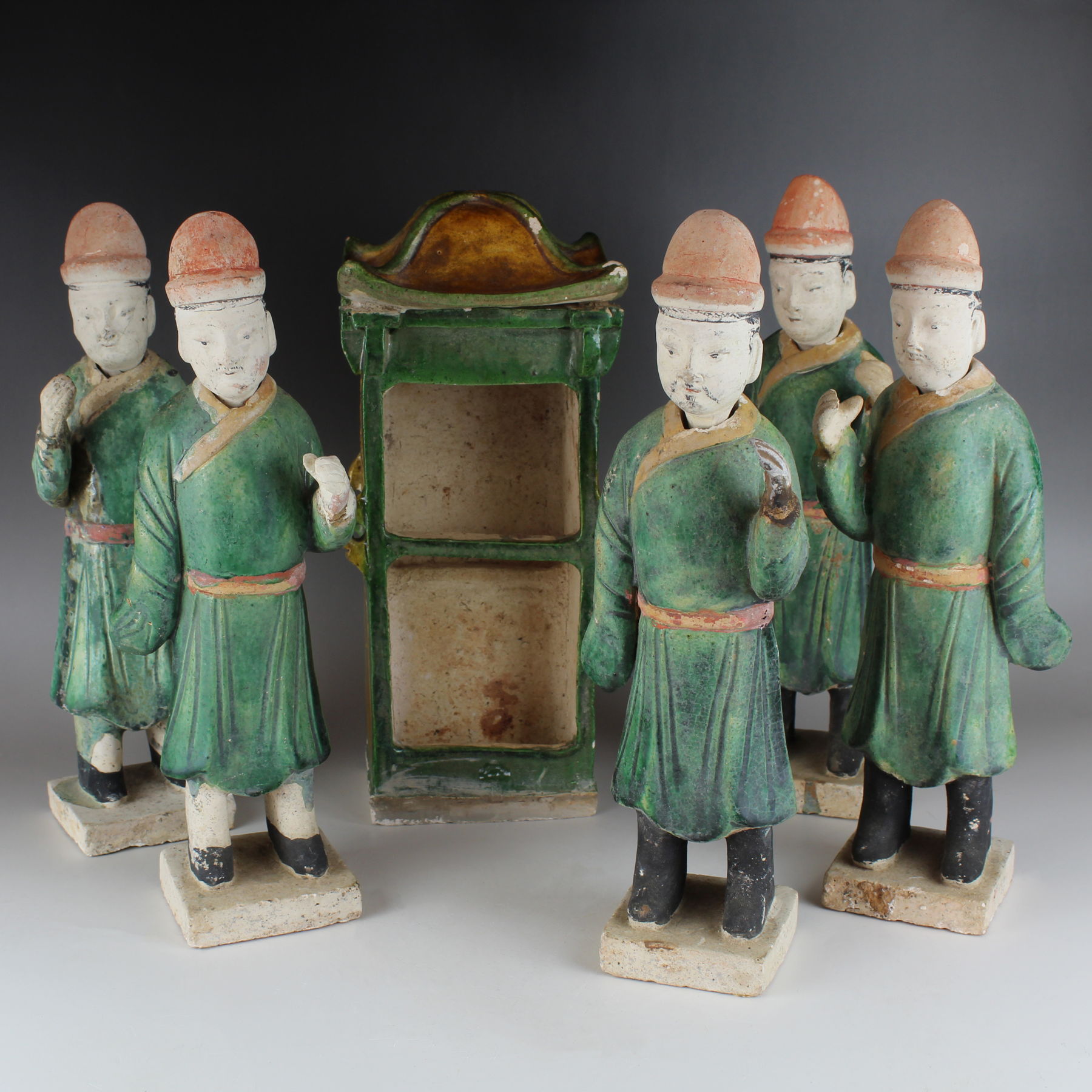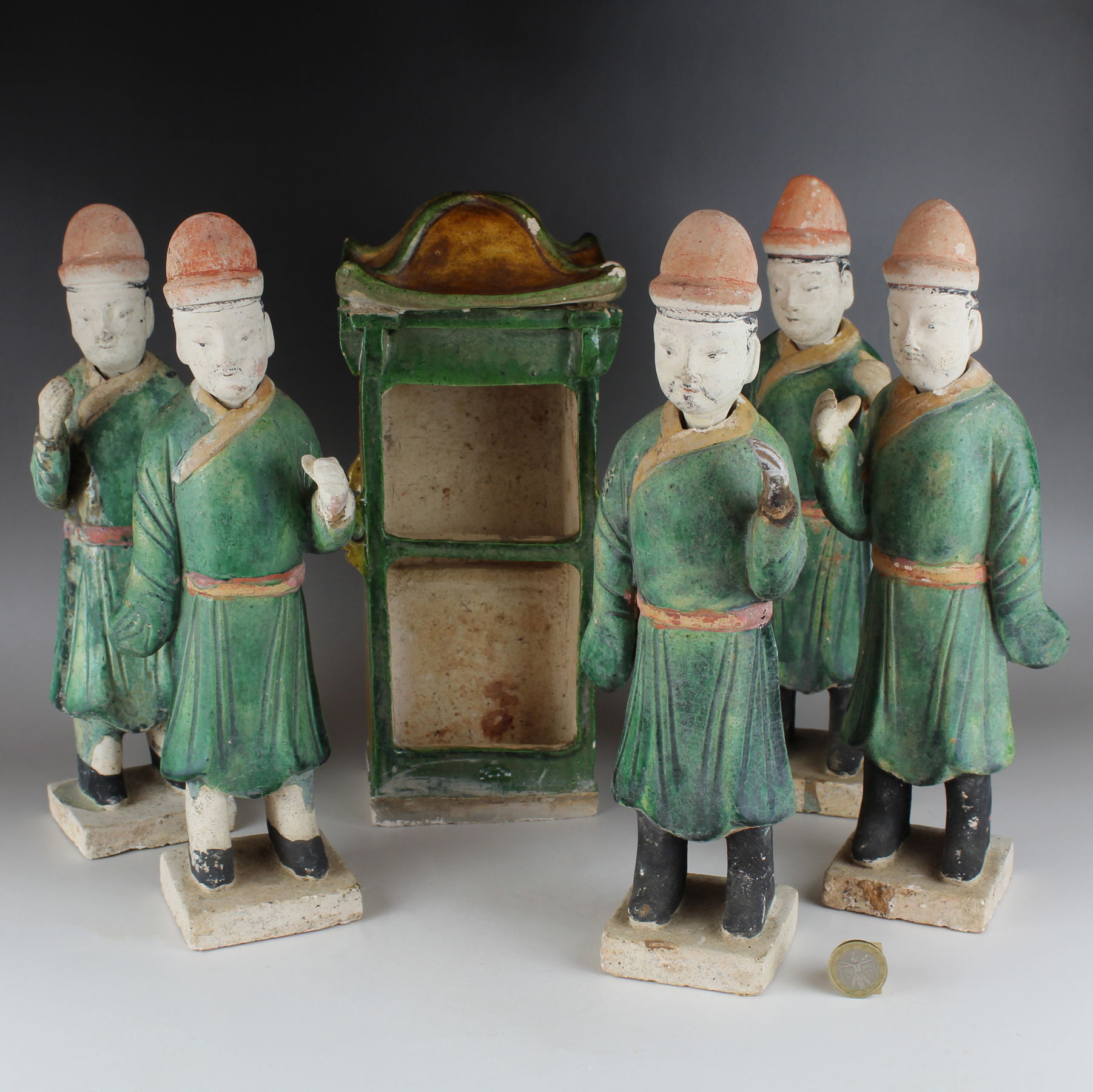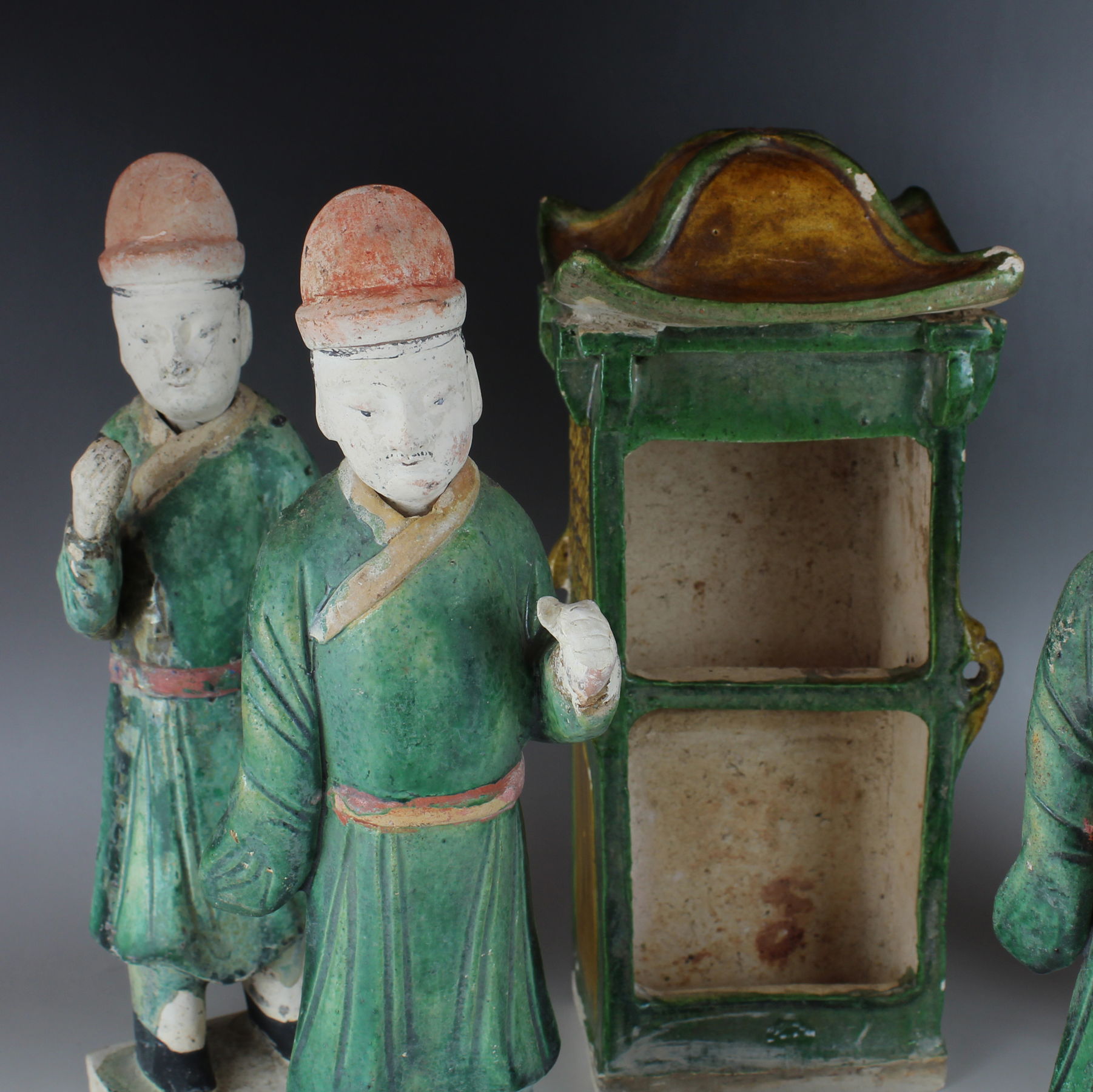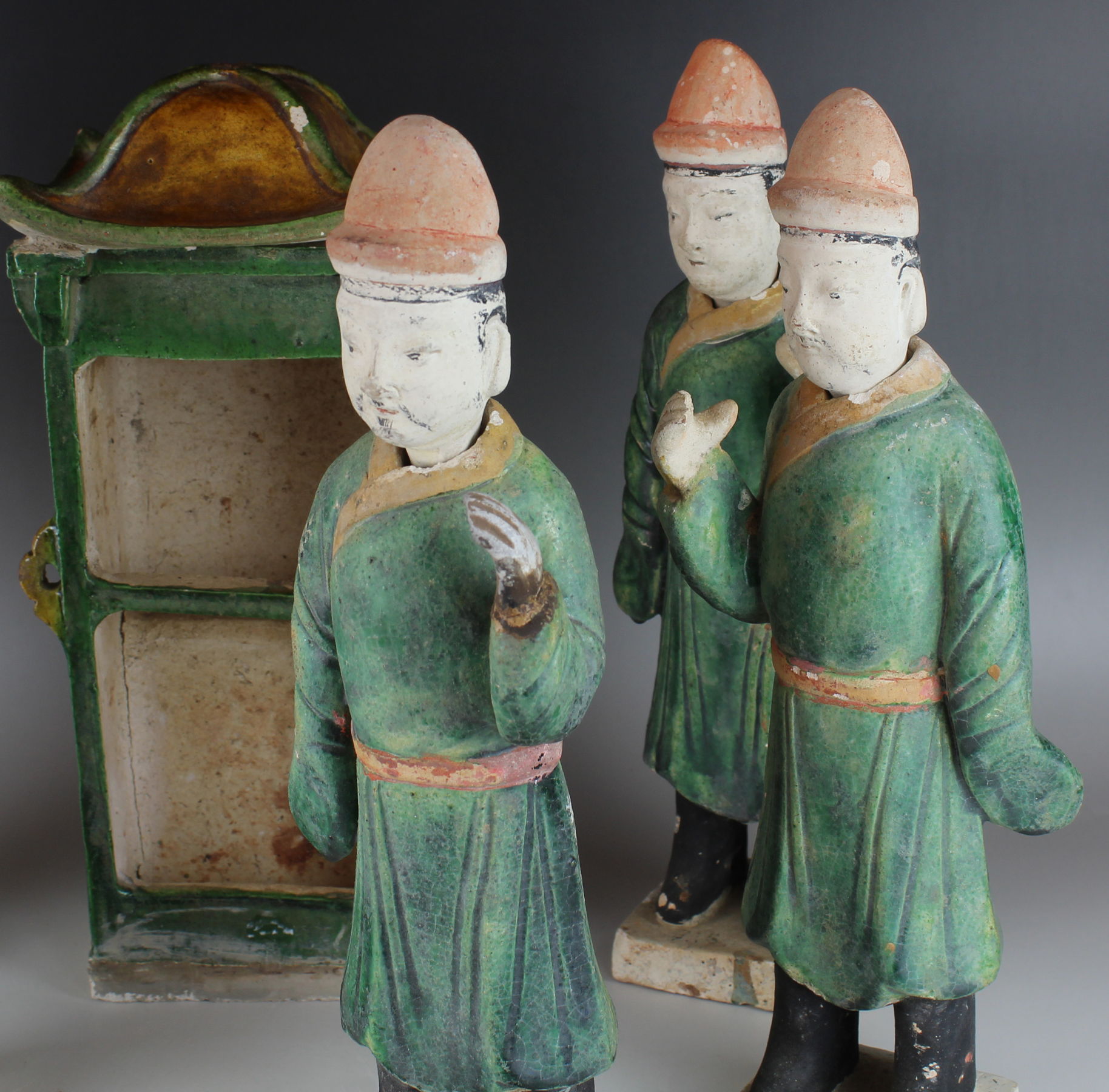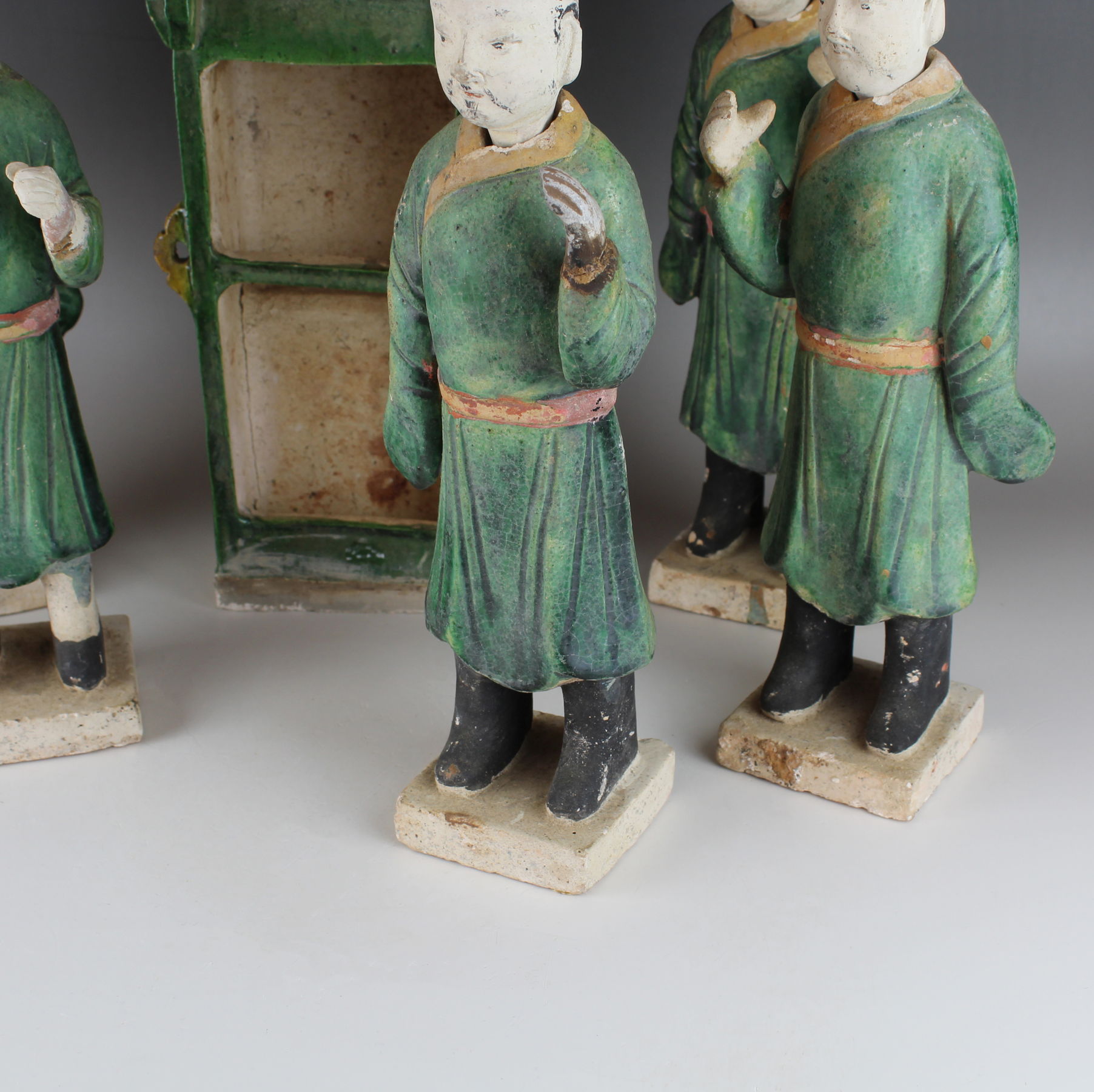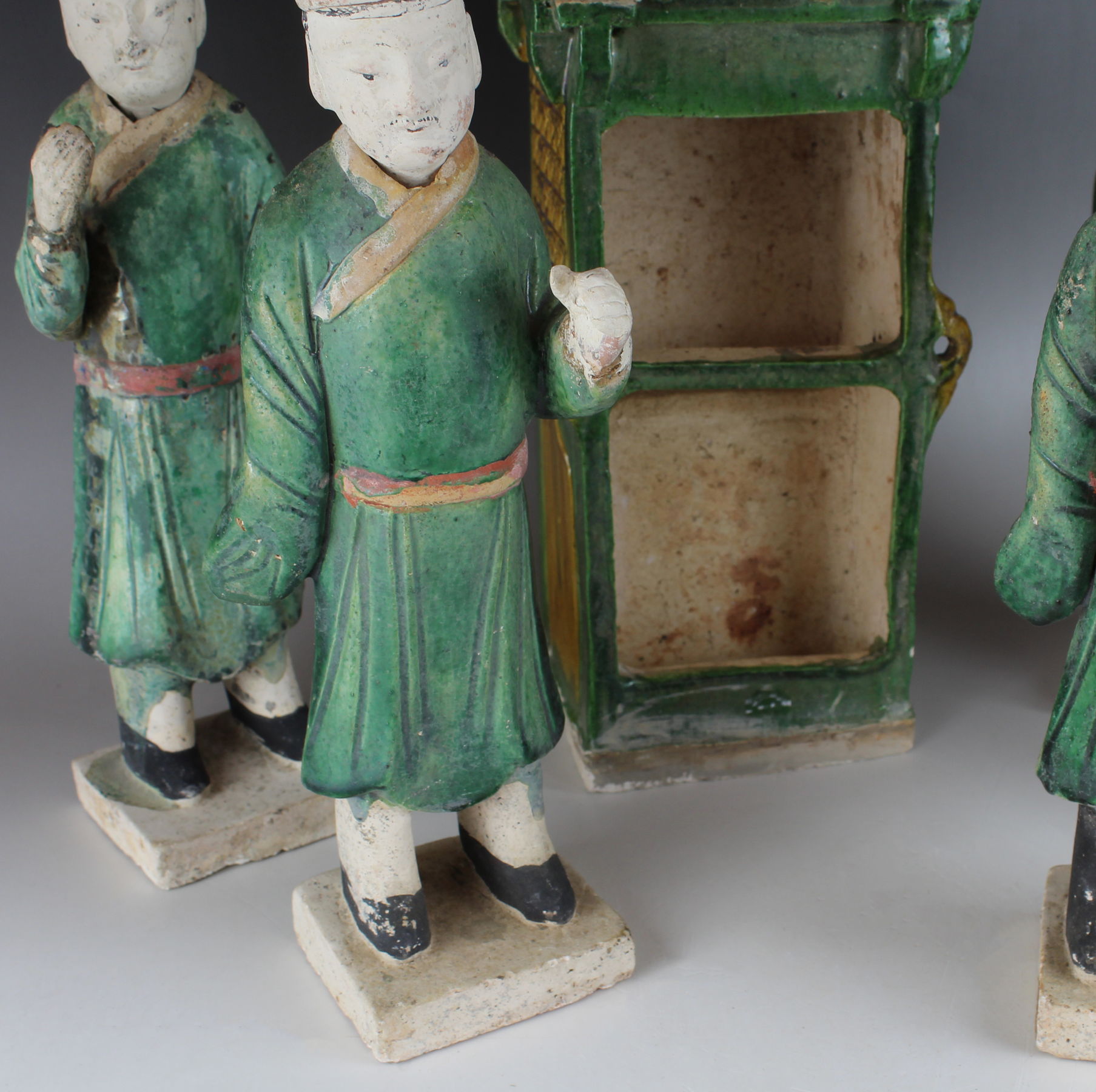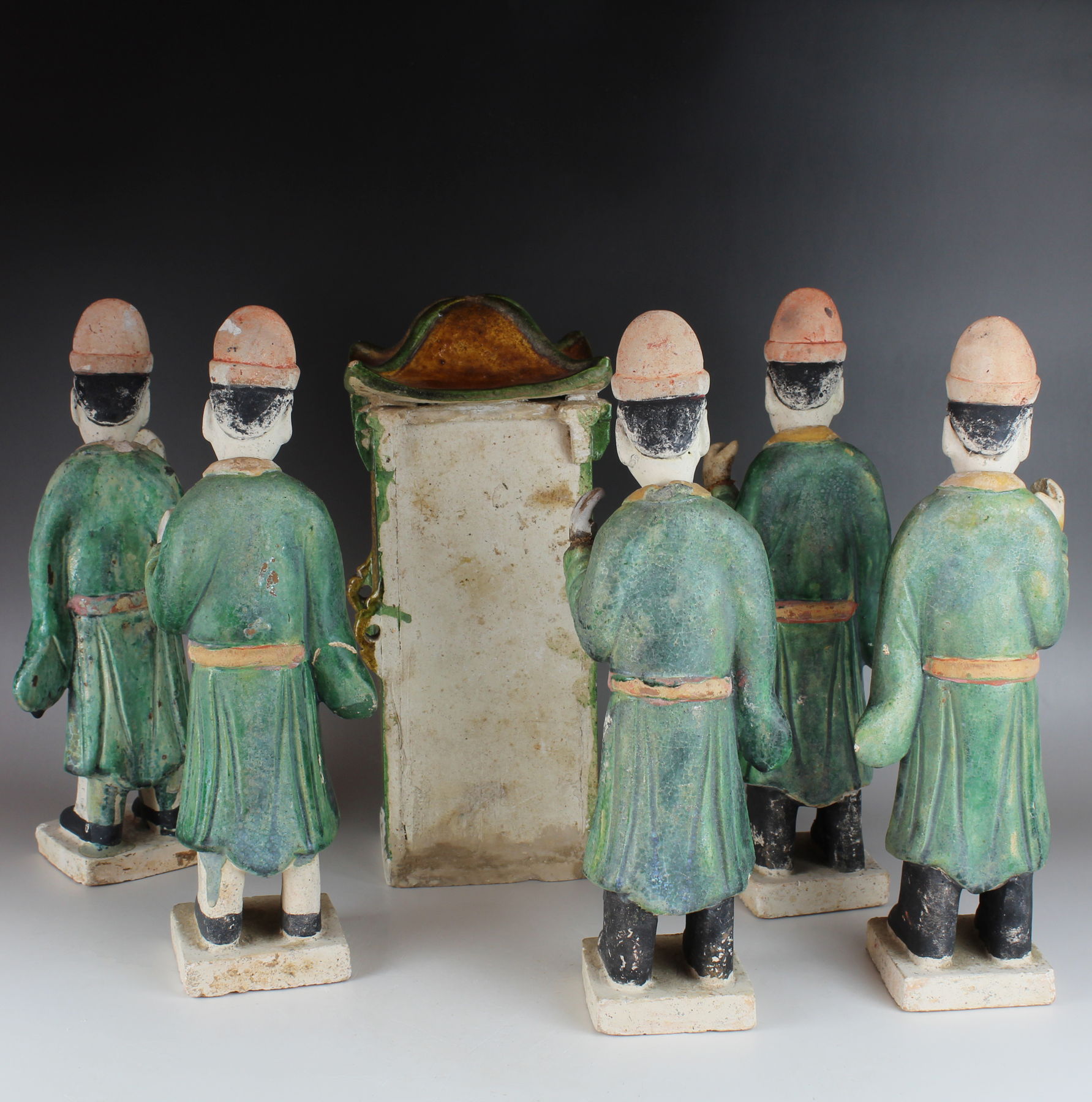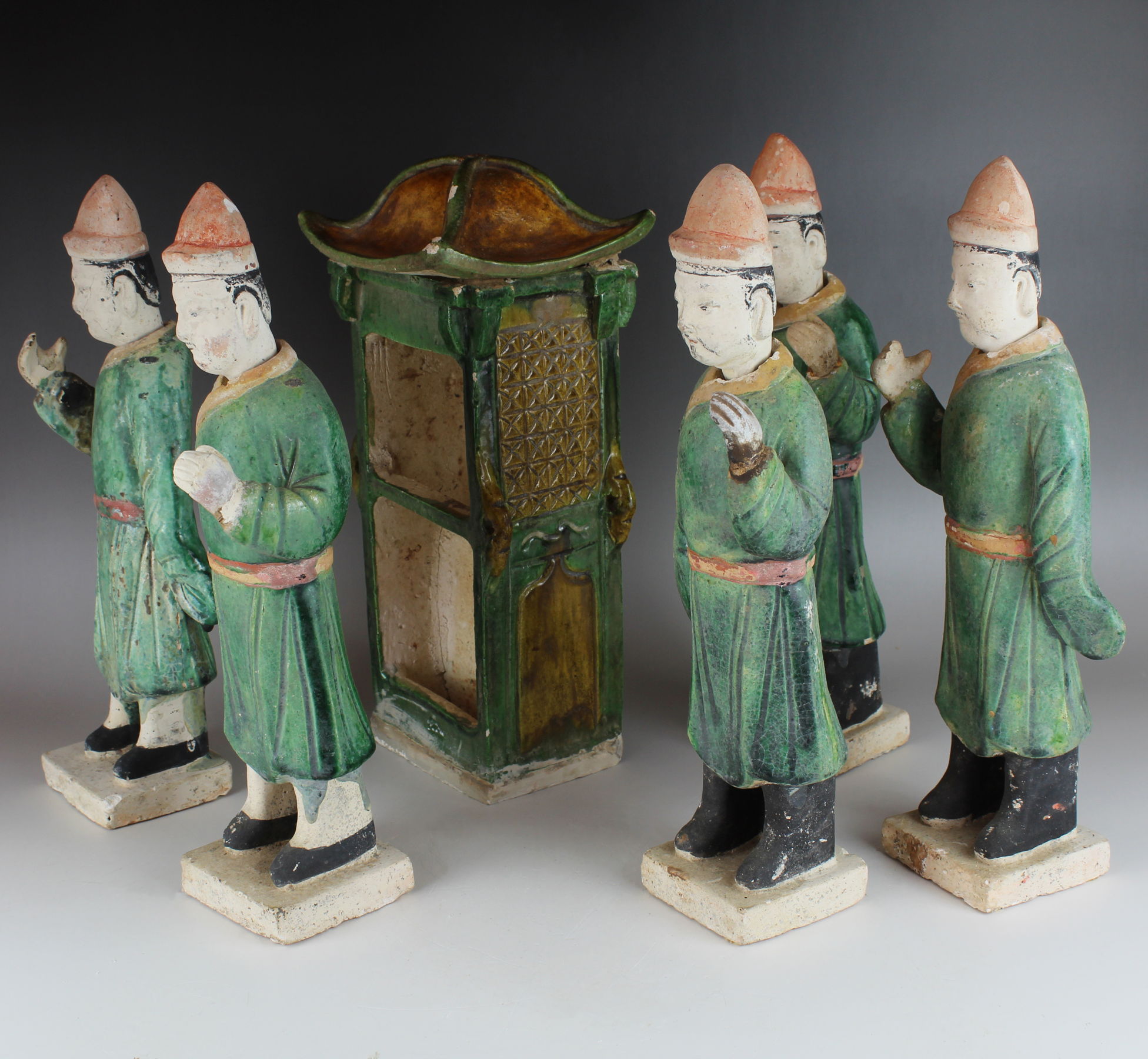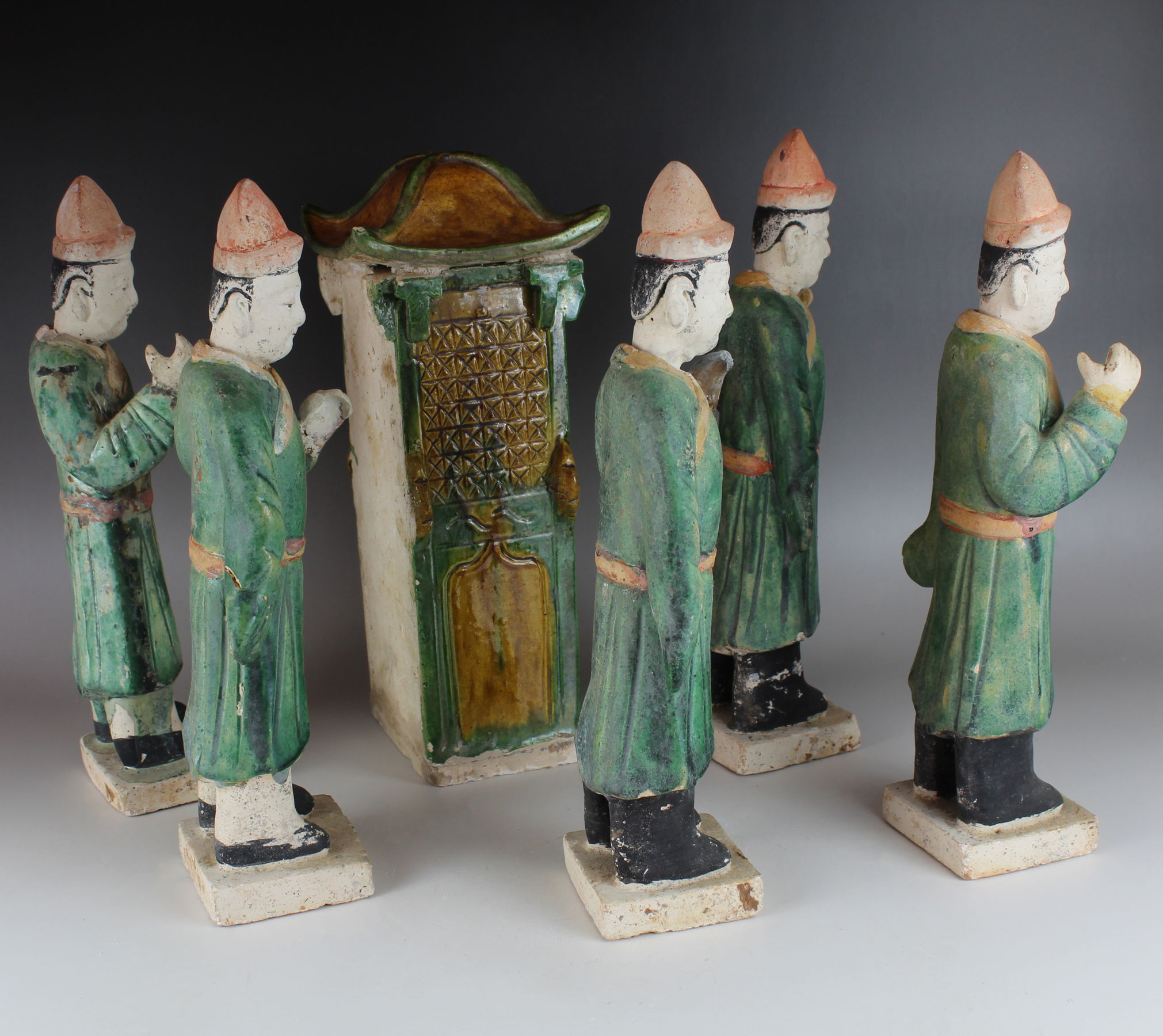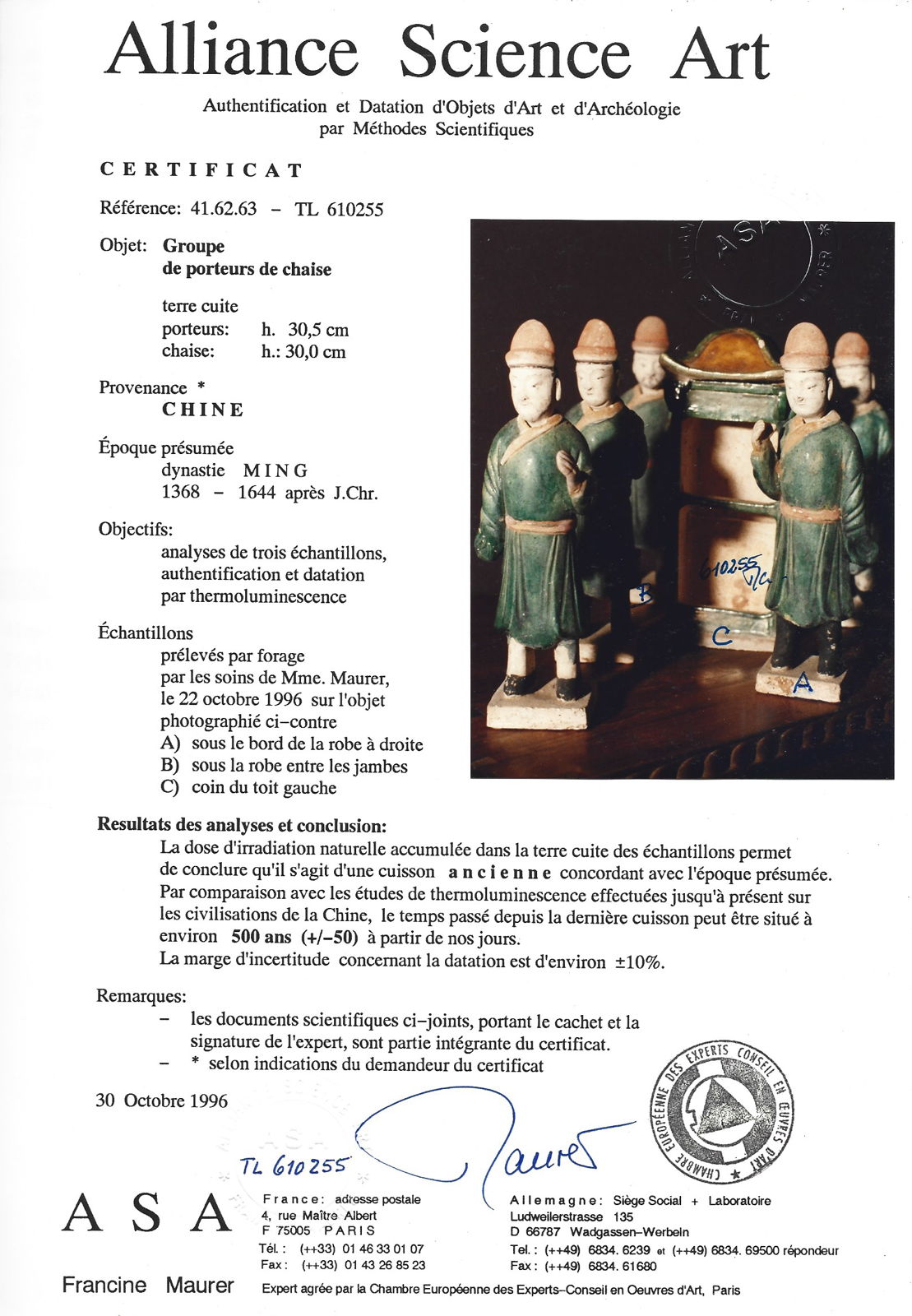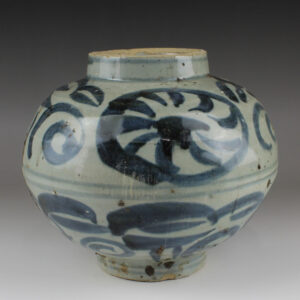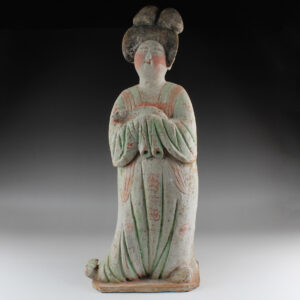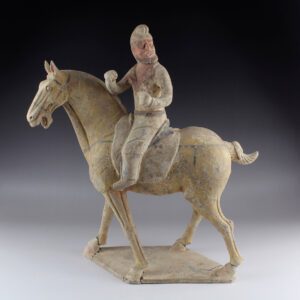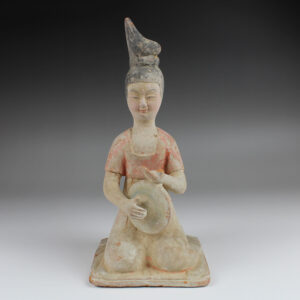Description
| ITEM | Palanquin and court attendants |
| MATERIAL | Sancai glazed pottery |
| CULTURE | Chinese, Ming Dynasty |
| PERIOD | 1368 – 1644 A.D |
| DIMENSIONS | 300 mm x 108 mm (Palanquin), 300 mm x 72 mm (Court attendants) |
| CONDITION | Good condition. Includes Thermoluminescence test by Alliance Science Art (Reference 41.62.63 – TL 610255) |
| PROVENANCE | Ex French private collection, Toulouse, M.B., acquired before 1980s |
While northern traditions of Cizhou and Jun ware continued to decline, pottery production in the south expanded. It was chiefly centred on Jingdezhen, an ideal site because of the abundance of minerals used for porcelain manufacture—kaolin (china clay) and petuntse (china stone)—ample wood fuel, and good communications by water. Most of the celadon, however, was still produced in Zhejiang, notably at Longchuan and Chuzhou, whose Ming products are more heavily potted than those of the Song and Yuan and are decorated with incised and molded designs under a sea-green glaze. Celadon dishes, some of large size, were an important item in China’s trade with the Middle East, whose rulers, it was said, believed that the glaze would crack or change colour if poison touched it.
At Jingdezhen the relatively coarse-bodied shufu ware was developed into a hard white porcelain that no longer reveals the touch of the potter’s hand. The practically invisible designs sometimes carved in the translucent body are known as anhua (“secret decoration”). In the Yongle period (1402–24) the practice began of putting the reign mark on the base (see below marks and decoration in Chinese pottery). This was first applied to the finest white porcelain and to monochrome ware decorated with copper red under a transparent glaze. As aforementioned, a white porcelain with ivory glaze was also made at Dehua in Fujian.
In the early decades of the Ming, the repertoire of designs on Yuan blue-and-white was continued and refined. At first, this ware evidently was considered too vulgar for court use, and none bears the imperial reign mark until the Xuande period (1425–35). By this time the often crowded Yuan patterns had given way chiefly to dragons or floral motifs of great clarity and grace, vigorously applied in a thick, deep-blue pigment to dishes, vases, stem cups, and flattened pilgrim jars. Sometimes a richer effect was achieved by painting dragons in underglaze red on a blue ground or vice versa. In the Chenghua period (1464–87), the blue-and-white designs became somewhat tenuous and overrefined, and the characteristic wares made for the Zhengde emperor (1505–21) and his Muslim eunuchs often bear Arabic inscriptions. In the Jiajing (1521–67) and Wanli (1572–1620) periods, the imperial kilns were badly mismanaged, and their products were often of poor quality. Private factories, however, turned out lively wares until the end of the dynasty.
Overglaze painting was applied with delicate care in the Chenghua period, chiefly in the decoration of small wine cups with chicken motifs, much admired by Chinese connoisseurs. These “chicken cups” were already being copied later in the 16th century and again, very expertly, in the 18th. Overglaze painting soon became popular; it was applied in the 16th century in stronger colours brilliantly contrasted against a dead-white background. These vigorous wucai (“five-colour”) wares, which utilized a wide palette, were especially free and bold in the Jiajing and Wanli periods. Crude but lively imitations of these and of the blue-and-white of Jingdezhen were made in kilns in southern China partly for the Southeast Asian market and are known as “Swatow ware,” named after one of the export sites. Among the most impressive of Ming pottery types are the sancai (“three-colour”) wares, chiefly vases and jars decorated with floral motifs in turquoise, purple, yellow, and deep violet blue, the colours separated by raised lines in imitation of the metal strips used in cloisonné work (see below). This robust ware was made in several centres, the best of it between 1450 and 1550.
Beginning in the early 16th century, a new ceramic tradition emerged in the town of Yixing, on the western side of Lake Tai, catering to the tea taste of scholars in the nearby Suzhou area. Individually made, sometimes to order, rather than mass-produced, Yixing wares were often signed or even poetically inscribed by highly reputable master craftsmen, such as Shi Dabin of the Wanli era and Chen Mingyuan of the Qing dynasty Kangxi period. The wares were usually unglazed and derived their striking colours—brown, beige, reddish purple, yellow, black, and blue—after firing from the distinctive clays of the region and were known as “purple-sand” teapots. Pieces alternated between two body types: complex floral shapes and exquisitely simple geometric designs. Produced in relatively small quantities and treasured by Chinese collectors, these vessels attracted little attention outside China until the late 20th century.
北方的慈州器和钧瓷传统不断衰落,南方的陶器生产却在不断扩大。主要集中在景德镇,景德镇是一个理想的地点,因为这里有丰富的制瓷矿物–高岭土和石墩子–木柴燃料,而且水路交通良好。但大部分青瓷仍产于浙江,尤其是龙川和滁州,其明代产品比宋、元的产品更重盆,在海青釉下饰以刻划和模纹。青花瓷盘,有的尺寸较大,是中国与中东地区贸易的重要物品,据说中东地区的统治者认为,青花瓷盘的釉面如果碰到毒药就会裂开或变色。
在景德镇,相对较粗的叙府器被发展成一种坚硬的白瓷,不再显示出陶工的手感。在半透明的胎体上有时会刻上几乎看不见的图案,这就是所谓的 “密饰”。永乐年间(1402-24年)开始在底座上刻上年号(见下面中国陶器的年号和装饰)。这种做法首先应用于上等白瓷和透明釉下铜红装饰的单色器。如前所述,福建德化也有一种象牙釉的白瓷。
明初数十年,元青花上的纹饰品种得到了延续和完善。起初,这种器皿显然被认为太过粗俗,不适合宫廷使用,直到宣德年间(1425-35年)才有一件带有帝王印记。到了宣德年间,元代的纹样已经主要让位于清晰优美的龙或花纹,在盘子、花瓶、柄杯、扁形朝圣罐等器物上,都用浓厚的深蓝色颜料。有时在蓝地上用釉下红画龙,或反过来画龙,效果更丰富。到了成化年间(1464-87年),蓝白设计变得有些脆弱和过于精致,为正德皇帝(1505-21年)和他的穆斯林太监制作的特色器皿上常有阿拉伯文的铭文。嘉靖(1521-67)、万历(1572-1620)时期,御窑管理不善,产品往往质量不佳。但是,私人工厂生产的产品一直到王朝末期都很热闹。
成化年间,釉上彩应用得很细致,主要用于装饰鸡纹小酒杯,深受中国鉴赏家的喜爱。这种 “鸡杯 “在16世纪后期就已经开始仿制,18世纪又开始仿制,非常专业。釉上彩很快就流行起来了,16世纪的时候,釉上彩的色彩更加浓烈,与白茫茫的背景形成鲜明的对比。這些五彩的器物,運用寬廣的調色板,在嘉靖、萬曆時期特別自由、大膽。在中国南方的窑场里,有一些粗制滥造的仿制品,部分是为东南亚市场而制作的,被称为 “汕尾器”,是以出口地之一命名的。明代陶器中最令人印象深刻的是三彩器,主要是以绿松石、紫、黄、深紫蓝色的花纹为装饰的花瓶和罐子,颜色以仿景泰蓝的金属条分开(见下文)。这种坚固的器皿在几个中心制作,其中最好的是在1450年至1550年之间。
从16世纪初开始,太湖西边的宜兴镇出现了一种新的陶瓷传统,以迎合附近苏州地区学者的茶叶口味。宜兴器物多为单独制作,有时也是按订单生产,而不是批量生产,往往由名声显赫的工匠,如万历年间的石大彬、清康熙年间的陈明远等人署名甚至题诗。紫砂茶壶一般不施釉,以当地特有的泥土烧制而成,颜色醒目,有褐色、米黄色、红紫色、黄色、黑色、蓝色等,被称为 “紫砂 “茶壶。壶身有两种类型:复杂的花形和精巧简单的几何图案。壶身有两种类型:复杂的花形和精美简洁的几何图案,产量较少,为中国收藏家所珍视,但直到20世纪末,这些器皿在中国以外的地方很少受到关注。


